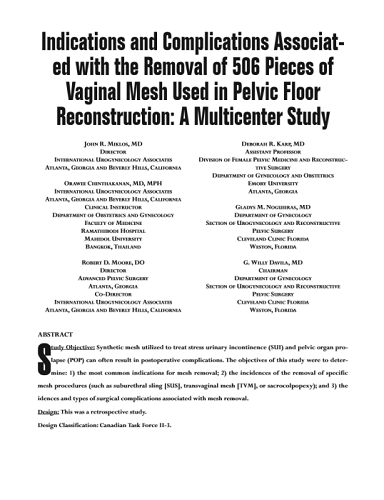WHAT ARE THE SIGNS AND SYMPTOMS OF PELVIC MESH COMPLICATIONS?
When patients and surgeons talk about pelvic mesh, they could be speaking about one of many different types of mesh procedures, including TVT slings, TOT slings, single incision slings, sacralcolpopexy, anterior vaginal mesh, posterior vaginal mesh and vaginal vault mesh. The symptoms associated with these mesh procedures include:
Mesh exposure – the most common complication. Mesh exposure is transvaginal mesh can become exposed so one can see the mesh coming through the vaginal skin, but it does NOT protrude beyond the height of the skin, this can cause bleeding, infection, pain or painful intercourse for the patient and her partner.
Mesh extrusion – mesh is exposed through the skin but is protruding above and beyond the borders of the skin.
Chronic Pain – the 2nd most common & most devastating complications of transvaginal mesh surgery. This can be caused by nerve damage, mesh erosion into the vaginal skin or neighboring organs such as bladder, urethra, rectum, small or large bowel, or excessive scar tissue which can pull on nerves resulting in pain.
Painful sex – the mesh can cause painful intercourse for the patient and/or her partner. Again, the scar tissue can cause pain by tension on nerves or exposure, extrusion, or erosion of mesh.
Infection- which may result in tissue or organ wall infection which can manifest as a symptom of pain, fever, or discharge.
Mesh exposure -transvaginal mesh can become exposed so one can see the mesh coming through the vaginal skin, but it does NOT protrude beyond the height of the skin., this can cause pain or painful intercourse for the patient and her partner as well as bleeding and infection.
Mesh erosion – is like mesh exposure however instead of the mesh migrating or being seen on the outside i.e., as a disruption in the skin of the vagina, instead during erosion one would see the mesh penetrating the inside of a neighboring organ such as the urethra, bladder, or rectum. When this happens common signs or symptoms include pain, bleeding, infection, painful intercourse, or potentially blood in the urine or in the feces, and pain during urination or defecation.
Urinary problems – may include:
- complete urine retention,
- inability to empty one’s bladder,
- urgency
- frequency
- overactive bladder
- recurrent urinary tract infections
- urinary incontinence.
If you are experiencing any of these signs or symptoms after undergoing mesh surgery, it is important to consult with an experienced mesh removal surgeon or healthcare provider for proper evaluation and treatment. All too often patients who are having mesh failures are dismissed by their healthcare provider or inappropriately evaluated and treated. Failure to remove the mesh appropriately or in a timely fasion can lead to further complications and worsening symptoms. In some patients removing only a portion of the mesh is the correct thing to do but in other patients it can make it much more difficult to remove the remainder of the mesh, as it makes it more difficult to find and appropriately extract.
WHY CHOOSE MIKLOS & MOORE UROGYNECOLOGY TO SOLVE YOUR PELVIC MESH COMPLICATIONS?
Dr. Miklos is a highly experienced and skilled surgeon who specializes in the treatment of mesh complications. He has removed more than 1,000 pieces of mesh and has been removing mesh since 1994. Few surgeons in the world can make this claim. Dr. Miklos has a patient-centered approach to care and listens to the patient’s point of view which is not always supported by the scientific literature. He has removed mesh on patients who were previously evaluated and even had surgeries by surgeons at: Cleveland Clinic, Mayo Clinic, Duke University, Harvard, Vanderbilt, Emory University… He takes the time to thoroughly evaluate each patient’s unique situation and develop a personalized treatment plan. He makes recommendations but allows each patient to make the final decision as to the surgery and technique. He truly believes that he makes the patient an informed consumer so she can ultimately make the right decision to minimize or stop the’ pain and suffering. Overall, choosing Dr. Miklos for your mesh complication surgery can provide you with the expert care and support you need to achieve the best possible outcome.
Dr Miklos has:
EXPERIENCE -Dr. Miklos has been removing mesh since 1998 and have seen, treated, or removed just about every type of transvaginal mesh complication known to man. He has removed more than 1000 pieces of mesh with minimal complications and superior success. The largest USA paper written on mesh removal is a series of 506 pieces of mesh in 3.5 years and Dr Miklos was responsible for removing 400 of the 506 pieces of mesh. (Figure 1) Surgical experience is only half of the battle as making the correct diagnosis is just as important. This too requires experience! First and foremost, Dr. Miklos listens to his patients and listening to the patient is one of the most important details in making the correct diagnosis. Once the correct diagnosis is make then the patient can proceed with surgery. Most doctors will not only make the incorrect diagnosis, but they also never make the connection that the mesh can be the cause of the patients symptoms.
EXPERTISE – They have treated patients from all over the world for mesh complications. They have produced award-winning videos which have gotten them international acclaim for their mesh-removing technique. Dr. Miklos has taught and given mesh lectures around the world including: Australia, North America, South America, Europe and Africa.
KNOWLEDGE – Dr. Miklos is a Rule 26 medical legal expert. He is considered an expert in the treatment of patients with mesh complications. He understand the science behind using mesh for prolapse and urine incontinence using mesh as well as an expert in the treatment of mesh complications. He is also considered a leader in the world on the surgical treatment of mesh complications as he has authored or coauthored 2 of the largest papers on mesh complications found in the worldwide literature.
RESULTS – Miklos & Moore Urogynecology have addressed and removed some of the most difficult transvaginal mesh devices made and inserted in the human body. Though no one can guarantee the success rate for fixing the patient’s symptoms, Dr Miklos can usually remove >95% of the mesh load > 90% of the time. He can totally remove the complete mesh most of the time if the patient so desires or it is medically indicated.
Here at Miklos & Moore Urogynecology, we have removed mesh from inside the urethra, bladder, rectum, and small bowel. We have repaired fistulas due to the mesh in the bladder, urethra, and rectum as well as sinus tracts in the vagina, elevator ani muscle, ischia rectal fossa (ie. an area of the buttocks cheek. Dr Miklos has removed as many as 3 mesh slings in one patient and 4 mesh devices in another patient during one operation. (FIGURE 2) He has removed full length i.e., total TVT slings (FIGURE 3) and (VIDEO 1), full length i.e., total TOT slings (FIGURE 4), and full i.e., total sacral colpopexy (FIGURE 5), and (VIDEO 2). In selected cases, Dr Miklos can also offer reconstructive surgery to repair further prolapse or incontinence after the mesh removal.




RECOVERY TIME AFTER PELVIC MESH REMOVAL SURGERY?
Recovery time is dependent upon the amount of mesh removed, the location of the removal as well as whether concurrent reconstructive surgery was performed. In general, is the patient is just getting mesh removal the patient is free to return to normal activity in 6 weeks.
However, if a patient is getting mesh removal and is going to have reconstructive surgery at the time of mesh removal, most likely their recovery will take12 weeks. This does not mean the patient will have pain the whole time, what it means is the reconstructive surgery will need time to heal and scar in place before resuming normal physical activity.
VIDEO 1: TOTAL SACRALCOLPOPEXY REMOVAL
VIDEO 2: TOTAL TVT SLING REMOVAL


